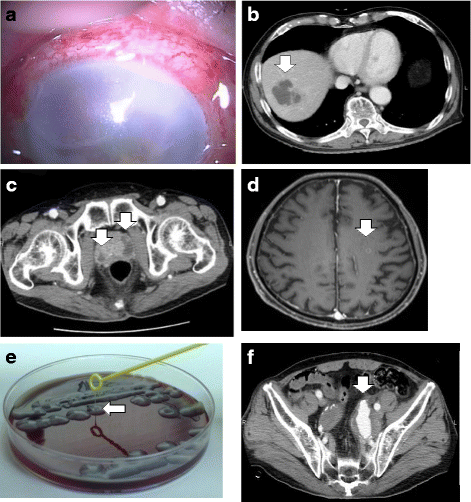Two unusual cases of successful treatment of hypermucoviscous Klebsiella pneumoniae invasive syndrome
- PMID: 27852233
- PMCID: PMC5112683
- DOI: 10.1186/s12879-016-2011-3
Two unusual cases of successful treatment of hypermucoviscous Klebsiella pneumoniae invasive syndrome
Abstract
Background: A few Japanese cases of hypermucoviscous Klebsiella pneumoniae (K. pneumoniae) invasive syndrome have recently been reported. Although extrahepatic complications from bacteremic dissemination have been observed, infected aneurysms are rare. Furthermore, the primary source of infection is generally a liver abscess, and is rarely the prostate. Therefore, we report two atypical cases of hypermucoviscous K. pneumoniae invasive syndrome.
Case presentation: The first case was an 81-year-old Japanese man with no significant medical history, who was referred to our hospital for vision loss in his right eye. Contrast-enhanced whole-body computed tomography revealed abscesses in the liver and the prostate, and an infected left internal iliac artery aneurysm. Contrast-enhanced head magnetic resonance imaging revealed brain abscesses. Cultures of the liver abscess specimen and aqueous humor revealed K. pneumoniae with the hypermucoviscosity phenotype, which carried the magA gene (mucoviscosity-associated gene A) and the rmpA gene (regulator of mucoid phenotype A). We performed enucleation of the right eyeball, percutaneous transhepatic drainage, coil embolization of the aneurysm, and administered a 6-week course of antibiotic treatment. The second case was a 69-year-old Japanese man with diabetes mellitus, who was referred to our hospital with fever, pollakiuria, and pain on urination. Contrast-enhanced whole-body computed tomography revealed lung and prostate abscesses, but no liver abscesses. Contrast-enhanced head magnetic resonance imaging revealed brain abscesses. The sputum, urine, prostate abscess specimen, and aqueous humor cultures revealed K. pneumoniae with the hypermucoviscosity phenotype, which carried magA and rmpA. We performed enucleation of the left eyeball, percutaneous drainage of the prostate abscess, and administered a 5-week course of antibiotic treatment.
Conclusions: Hypermucoviscous K. pneumoniae can cause infected aneurysms, and the prostate can be the primary site of infection. We suggest that a diagnosis of hvKP invasive syndrome should be considered in all patients who present with K. pneumoniae infection and multiple organ abscesses.
Keywords: Abscess; Endophthalmitis; Hypermucoviscous Klebsiella pneumoniae; Infected aneurysm; Prostate; String test; magA; rmpA.
Figures



Similar articles
-
Survey of Klebsiella pneumoniae bacteraemia in two South Australian hospitals and detection of hypermucoviscous phenotype and magA/rmpA genotypes in K . pneumoniae isolates.Infection. 2013 Apr;41(2):559-63. doi: 10.1007/s15010-012-0374-y. Epub 2012 Dec 8. Infection. 2013. PMID: 23225226
-
Association between rmpA and magA genes and clinical syndromes caused by Klebsiella pneumoniae in Taiwan.Clin Infect Dis. 2006 May 15;42(10):1351-8. doi: 10.1086/503420. Epub 2006 Apr 11. Clin Infect Dis. 2006. PMID: 16619144
-
Hypervirulent Klebsiella pneumoniae clones causing bacteraemia in adults in a teaching hospital in Barcelona, Spain (2007-2013).Clin Microbiol Infect. 2016 Feb;22(2):154-160. doi: 10.1016/j.cmi.2015.09.025. Epub 2015 Oct 8. Clin Microbiol Infect. 2016. PMID: 26454059
-
Klebsiella pneumoniae liver abscess: a new invasive syndrome.Lancet Infect Dis. 2012 Nov;12(11):881-7. doi: 10.1016/S1473-3099(12)70205-0. Lancet Infect Dis. 2012. PMID: 23099082 Review.
-
Liver abscess in the caudate lobe caused by Klebsiella pneumoniae: a rare case report and literature review.BMC Infect Dis. 2024 Jul 19;24(1):708. doi: 10.1186/s12879-024-09569-6. BMC Infect Dis. 2024. PMID: 39030483 Free PMC article. Review.
Cited by
-
Klebsiella pneumoniae invasion syndrome: a case of liver abscess combined with lung abscess, endophthalmitis, and brain abscess.J Int Med Res. 2022 Mar;50(3):3000605221084881. doi: 10.1177/03000605221084881. J Int Med Res. 2022. PMID: 35345919 Free PMC article.
-
Emerging Multiorgan Klebsiella pneumoniae Invasive Syndrome Leading to Septic Shock: A Case Report and Review of the Literature.Cureus. 2022 Jul 7;14(7):e26647. doi: 10.7759/cureus.26647. eCollection 2022 Jul. Cureus. 2022. PMID: 35949763 Free PMC article.
-
The first case of abdominal mycotic aneurysm caused by K1 hypervirulent Klebsiella pneumoniae in a healthy adult.Acute Crit Care. 2021 Nov;36(4):390-394. doi: 10.4266/acc.2021.00010. Epub 2021 Nov 16. Acute Crit Care. 2021. PMID: 34510884 Free PMC article.
-
A rare case of hypervirulent Klebsiella pneumoniae liver abscess and bacterial endophthalmitis associated with distal bile duct cancer.Clin J Gastroenterol. 2024 Aug;17(4):731-736. doi: 10.1007/s12328-024-01985-0. Epub 2024 Jun 18. Clin J Gastroenterol. 2024. PMID: 38888806
-
Delayed right external iliac artery disruption after radical cystectomy: A case report and literature review.Mol Clin Oncol. 2023 Aug 1;19(3):74. doi: 10.3892/mco.2023.2670. eCollection 2023 Sep. Mol Clin Oncol. 2023. PMID: 37614370 Free PMC article.
References
-
- Chang FY, Chou MY, Fan RL, Shaio MF. A clinical study of Klebsiella liver abscess. Taiwan Yi Xue Hui Za Zhi. 1988;87(3):282–7. - PubMed
-
- Maruno T, Ooiwa Y, Takahashi K, Kodama Y, Takakura S, Ichiyama S, et al. A liver abscess deprived a healthy adult of eyesight: endogenous endophthalmitis associated with a pyogenic liver abscess caused by serotype K1 Klebsiella pneumonia. Intern Med. 2013;52(8):919–22. doi: 10.2169/internalmedicine.52.9076. - DOI - PubMed
Publication types
MeSH terms
Substances
LinkOut - more resources
Full Text Sources
Other Literature Sources

